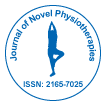Transcutaneous Electrical Nerve Stimulation, Laser, photobiomodulation, pain, cervical disc herniation.
Received Date: Feb 25, 2025 / Published Date: Mar 15, 2025
Abstract
Cervical disc herniation (CDH) is caused by prolapse of the nucleus pulposus, which presses on nerve roots or the spinal cord in the neck, causing neuropathic pain due to nerve dysfunction or compression, mainly in the C5- C6 and C6-C7 roots, resulting in symptoms such as chronic pain, burning and allodynia in the ipsilateral arm. The objective of this study is to evaluate the combined therapy of Transcutaneous Electrical Nerve Stimulation (TENS) and photobiomodulation to stimulate nerve fibers and increase cellular energy production, aiming at the reduction of pain and inflammation. This non-invasive and non-pharmacological method aims to provide a faster therapeutic response than conventional therapy, resulting in well-being and quality of life for the patient. The study was carried out at the Photodynamic Therapy Unit of Santa Casa (PTU) - São Carlos, with 1 male patient, 49 years old, diagnosed with disc herniation in the cervical region (C5-C6), with radiating pain in the right upper limb and functional limitations, such as restrictions of cervical spine movements. The methods used were the prototype equipment that consists of the synergy of electric current emissions (TENS) and Laser. The protocol consisted of 10 treatment sessions, twice a week, lasting 30 minutes, using synergistically the TENS with continuous stimulation of 100Hz, 100μs and sensory intensity, and the therapeutic laser of 660nm and 808nm, applied in the region of the corresponding dermatome. As a form of evaluation, the goniometric measurement of the articular angles of the cervical spine, the Visual Analogue Scale (VAS), the Neck Disability Index Questionnaire (NDI) and the Quality of Life Questionnaire SF-36 were used. The results obtained were improvement and greater amplitude in relation to movements, reduction in relation to pain, reflected in the increase in functional capacity, reduction of limitations caused by physical and emotional problems, greater vitality, improvement in the general state of health, greater participation in social activities and reduction of symptoms of anxiety and stress. This case study with the synergistic use of TENS and photobiomodulation as a resource for pain relief in inflammation and joint movements due to CDH, contributed to emotional well-being and an overall improvement in the patient's quality of life in 5 weeks of treatment.
Citation: Canelada ACN, Garcia V, Gianini CA, Jamami LK, Antônio MHC, et al. (2025) Transcutaneous Electrical Nerve Stimulation (TENS) and Photobiomodulation promote improvement in Cervical Radicular Pain Due to Disc Herniation? Case Study. J Nov Physiother 15: 803.
Copyright: © 2025 Canelada ACN, et al. This is an open-access article distributed under the terms of the Creative Commons Attribution License, which permits unrestricted use, distribution, and reproduction in any medium, provided the original author and source are credited.
Select your language of interest to view the total content in your interested language
Share This Article
Recommended Journals
Open 91��ɫ Journals
Article Usage
- Total views: 320
- [From(publication date): 0-0 - Aug 04, 2025]
- Breakdown by view type
- HTML page views: 281
- PDF downloads: 39
